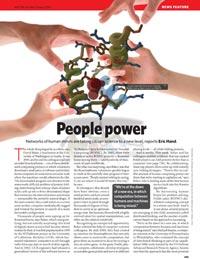 The whole thing began by accident, says David Baker, a biochemist at
the University of Washington in Seattle. It was 2005, and he and his
colleagues had just unveiled Rosetta@home
— one of those distributed-computing projects in which volunteers
download a small piece of software and let their home computers do some
extracurricular work when the machines would otherwise be idle. The
downloaded program was devoted to the notoriously difficult problem of
protein folding: determining how a linear chain of amino acids curls up
into a three-dimensional shape that minimizes the internal stresses and
strains — presumably the protein's natural shape. If the users wanted,
they could watch on a screen saver as their computer methodically tugged
and twisted the protein in search of a more favourable configuration.
The whole thing began by accident, says David Baker, a biochemist at
the University of Washington in Seattle. It was 2005, and he and his
colleagues had just unveiled Rosetta@home
— one of those distributed-computing projects in which volunteers
download a small piece of software and let their home computers do some
extracurricular work when the machines would otherwise be idle. The
downloaded program was devoted to the notoriously difficult problem of
protein folding: determining how a linear chain of amino acids curls up
into a three-dimensional shape that minimizes the internal stresses and
strains — presumably the protein's natural shape. If the users wanted,
they could watch on a screen saver as their computer methodically tugged
and twisted the protein in search of a more favourable configuration.
Thousands of people were signing up for Rosetta@home, says Baker, which was gratifying, but not entirely surprising; this kind of digital citizen science had become almost routine by then. It was first popularized in 1999 by the SETI@home project at the University of California, Berkeley (UCB), which harnessed volunteers' computers to sift through radio telescope data in search of alien signals. And in 2002, UCB engineers had released a generalized version of the software known as the Berkeley Open Infrastructure for Network Computing (BOINC). By 2005, there were dozens of active BOINC projects — Rosetta@home among them — and hundreds of thousands of users worldwide.
To read the full, original article click on this link: Citizen science: People power : Nature News
Author:

